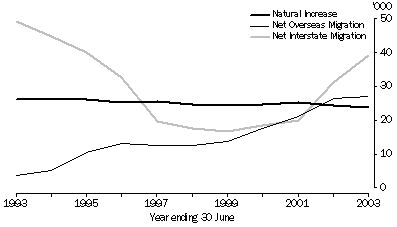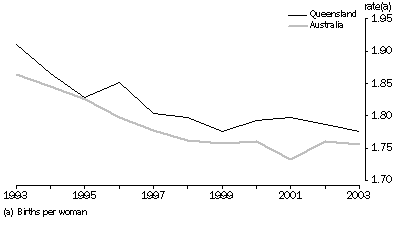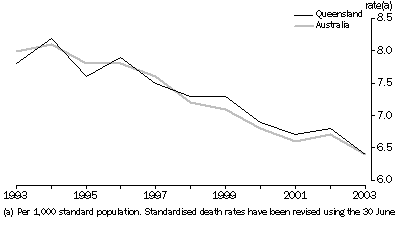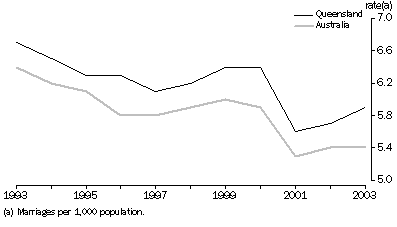OVERVIEW
This electronic product provides a demographic overview of Queensland, 2003. It contains summary tables and commentary on trends in the components of population change including births, deaths and migration. Marriages, divorces, estimated resident population and various demographic rates are also presented. Population and migration data are for the year ended 30 June 2003, while births, deaths, marriages and divorces data are for the year ended 31 December 2003.
For comparisons between the states and territories of Australia, please refer to Demography, Australia, 2003 (cat. no. 3311.0.55.001). Demography publications for each state and territory can be accessed from the following links:
Additional state demographic data are also available from publications and data cubes linked at the foot of this page. The Demography Theme Page provides links to other Australian as well as international demographic statistics. The National Regional Profiles provide economic and social statistics of Statistical Local Areas and Local Government Areas of Australia.
INQUIRIES
For further information about these and related statistics, contact the National Information and Referral Service on 1300 135 070 or Peter Burke on Brisbane (07) 3222 6069.
SUMMARY COMMENTARY
INTRODUCTION
As at 30 June 2003, Queensland had a population of 3,801,000 persons accounting for 19% of the Australian population. Queensland had the highest rate of population growth of all states and territories during 2002-03.
Queensland's crude marriage rate also continued to be the highest for any state or territory, while the crude birth and divorce rates were higher than the national average in 2003.
POPULATION
The estimated resident population of Queensland at 30 June 2003 was 3,801,000 persons, consisting of 1,897,100 males and 1,903,900 females.
Between 30 June 2002 and 30 June 2003, Queensland's population grew at a rate of 2.4%. This remained the highest rate of growth for all states and territories and is above the Australian average of 1.2%.
The population increase during 2002-03 was 90,100 persons, comprising net interstate migration of 39,200 persons, net overseas migration of 27,100 persons and a natural increase of 23,700 persons.
Persons aged under 15 years comprised 20.8% of the Queensland population at 30 June 2003 compared with 22.4% in 1993. Over this ten-year period, the proportion of persons aged 65 years and over has increased from 11.0% to 11.9% and for those aged 85 years and over from 0.9% to 1.3%.
POPULATION COMPONENTS, Queensland - 1993-2003

POPULATION, Queensland - Selected years at 30 June |
|
 |  |  | 1993 | 2002 | 2003 |
|
| Estimated resident population | ('000) | 3,109.8 | 3,711.0 | 3,801.0 |
| Components of population change(a) |  |  |  |  |
 | Natural increase(b) | no. | 26,065 | 24,337 | 23,738 |
 | Net overseas migration(c) | no. | 3,719 | 26,488 | 27,122 |
 | Net interstate migration | no. | 49,162 | 31,201 | 39,207 |
| Total increase(d) | no. | 79,838 | 82,026 | 90,067 |
| Annual growth rate | % | 2.63 | 2.26 | 2.43 |
| Estimates resident households(e) | ('000) | 1,136.3 | (f)nya | (f)nya |
|
| nya not yet available |
| (a) From previous year. |
| (b) Births and deaths figures used to compile natural increase for population estimates are based on year of occurrence and may differ from births and deaths data based on year of registration displayed in the Births and Confinements and Deaths sections of this table. |
| (c) Until 1997 net overseas migration data for Jervis Bay, Christmas Island and Cocos (Keeling) Island were randomly allocated to the states and territories. For these years the sum of the components may therefore not equal net overseas migration. |
| (d) Includes intercensal discrepancy not accounted for by natural increase and net migration. |
| (e) 1993 figures are based on 1996 census, figures from 1997 on are based on 2001 census. |
| (f) Data is under review. |
BIRTHS AND CONFINEMENTS
In 2003, there were 47,600 confinements resulting in 48,300 live births registered to mothers usually resident in Queensland. There were 24,800 male births and 23,500 female births, giving a sex ratio of 105.8 males per 100 females. Queensland's crude birth rate of 12.7 births per 1,000 population was slightly higher than the rate for Australia as a whole (12.6 births per 100,000 population).
The total fertility rate (the average number of babies a female would bear during her lifetime if she experienced current age-specific fertility rates) was 1.78 babies per woman in 2003.
TOTAL FERTILITY RATES(a), Australia and Queensland - 1993-2003

The median age of Queensland mothers for all confinements increased to 29.7 years in 2003 from 29.5 years in 2002. The median age of Queensland mothers was also lower than for all Australia (30.5 years).
Exnuptial births represented 37.2% of all live births registered in Queensland in 2003, a figure substantially greater than the 29.2% in 1993.
In 2003, there were 743 sets of twins and higher order births registered, which means one in every 64 confinements resulted in a multiple birth in Queensland. This is an increase in multiple births from 1993 where one in every 72 confinements resulted in a multiple birth.
BIRTHS AND CONFINEMENTS(a), Queensland - Selected years |
|
 |  |  | 1993 | 2002 | 2003 |
|
| Live births |  |  |  |  |
 | Number | no. | 46,778 | 47,771 | 48,342 |
 | Crude birth rate(b) | rate | 15.0 | 12.9 | 12.7 |
 | Total fertility rate(c) | rate | 1.910 | 1.787 | 1.776 |
 | Net reproduction rate(d) | rate | 0.913 | 0.861 | 0.852 |
| All confinements |  |  |  |  |
 | Number | no. | 46,122 | 46,934 | 47,601 |
 | Median age of mother(e) | years | 28.3 | 29.5 | 29.7 |
| Nuptial confinements |  |  |  |  |
 | Number | no. | 32,636 | 29,680 | 29,837 |
 | Median age of mother(e) | years | 29.4 | 30.8 | 31.1 |
 | Median age of father(e) | years | 31.7 | 32.8 | 33.0 |
| First nuptial confinements |  |  |  |  |
 | Number | no. | 12,960 | 12,044 | 12,265 |
 | Median age of mother(e) | years | 28.0 | 29.7 | 29.9 |
|
| (a) Compiled on year of registration basis. |
| (b) Births per 1,000 population. |
| (c) Births per woman. |
| (d) Daughters surviving to reproductive age per woman. |
| (e) The age at which half the population is older and half is younger. |
DEATHS
In 2003, there were 23,500 registered deaths of persons usually resident in Queensland, comprising 12,600 males and 10,900 females. This was an decrease of 2.0% on the number registered in 2002 and an increase of 17.7% from 1993, when there were 20,000 deaths. The standardised death rates have fallen from 7.8 deaths per 1,000 population in 1993 to 6.4 deaths per 1,000 population in 2003.
STANDARDISED DEATH RATES(a), Australia and Queensland - 1993-2003

In 2003 the median age at death in Queensland and was 75.6 years for males and 81.9 years for females. This is slightly lower than the Australian median age at death of 76.2 years and 82.4 years respectively.
There were 230 infant deaths registered in 2003, a 17.0% decrease on the 280 infant deaths registered in 2002. In comparison, the number of infant deaths decreased by 5.1% for Australia as a whole between 2002 and 2003. The infant mortality rate in Queensland for 2003 was 4.8 per 1,000 live births, which is substantially lower than the 1993 rate of 7.0 per 1,000 live births.
Life expectancy at birth continued to increase. A male child born in 2003 in Queensland has a life expectancy of 77.6 years, while a female child has a life expectancy of 82.8 years.
DEATHS(a), Queensland - Selected years |
|
 |  |  | 1993 | 2002 | 2003 |
|
| Number | no. | 19,972 | 23,968 | 23,500 |
| Crude death rate(b) | rate | 6.4 | 6.5 | 6.2 |
| Standardised death rate(c) | rate | 7.8 | 6.8 | 6.4 |
| Median age at death(d) |  |  |  |  |
 | Males | years | 72.6 | 75.6 | 75.6 |
 | Females | years | 79.0 | 81.9 | 81.9 |
| Infant deaths |  |  |  |  |
 | Number | no. | 327 | 277 | 230 |
 | Infant mortality rate(e) | rate | 7.0 | 5.8 | 4.8 |
| Life expectancy at birth |  |  |  |  |
 | Males | years | 75.0 | 77.2 | 77.6 |
 | Females | years | 81.0 | 82.4 | 82.8 |
|
| (a) Compiled on year of registration basis. |
| (b) Deaths per 1,000 population. |
| (c) Deaths per 1,000 standard population. Standardised death rates have been revised using the 2001 standard population. |
| (d) The age at which there are as many people dying above the age as there are below it. |
| (e) Deaths per 1,000 live births. |
MIGRATION
In 2002-03, Queensland's population grew by 39,200 from interstate migration. This net gain was the result of 120,200 arrivals and 81,000 departures. This was an increase of 25.7% over the preceding year (31,200 persons), but falls short of the 1992-93 gain of 49,200 persons.
Net overseas migration during 2002-03 was 27,100, an increase of 2.4% over 2001-02 (26,500).
The net population gain from migration, combining both overseas and interstate migration, was 66,300 persons in 2002-03.
MIGRATION, Queensland - Selected years at 30 June |
|
 |  |  | 1993 | 2002 | 2003 |
|
| Overseas migration |  |  |  |  |
 | Permanent and long-term movement(a) |  |  |  |  |
 | Arrivals | no. | 29,459 | 60,711 | 64,447 |
 | Departures | no. | 20,946 | 35,845 | 36,686 |
 | Net overseas migration(b) | no. | 3,719 | 26,488 | 27,122 |
| Interstate migration |  |  |  |  |
 | Arrivals | no. | 118,967 | 110,266 | 120,246 |
 | Departures | no. | 69,805 | 79,065 | 81,039 |
 | Net Interstate migration | no. | 49,162 | 31,201 | 39,207 |
|
| (a) Based on stated intention on arrival or departure. |
| (b) Figures for year ending 30 June 1993 include an adjustment for category jumping. For years ending 30 June 2002 and 2003, figures have been adjusted for changes in traveller intention and multiple mover error. |
MARRIAGES
There were 22,300 marriages registered in Queensland in 2003. This represents an increase of 7.6% on the number of marriages in 1993 (20,700) and 4.7% in 2002 (21,300).
In 2003, the crude marriage rate for Queensland was 5.9 marriages per 1,000 population. Queensland continued to record the highest crude marriage rate of all states and territories, and was higher than the national average rate of 5.4 per 1,000 population. The crude marriage rate for Queensland has decreased 11.9% between 1993 and 2003.
CRUDE MARRIAGE RATES(a), Australia and Queensland - 1993-2003

The median age at marriage in Queensland was 31.4 years for males and 29.3 years for females in 2003. The difference of two years between the median age of partners has remained stable over the past decade.
The increasing preference for civil marriage ceremonies over religious marriage ceremonies continued in 2003. Civil celebrants performed 61.3% of all marriages in Queensland, while ministers of religion performed the remaining 38.7%. This compares with civil celebrants performing 44.0% of marriages in 1993.
MARRIAGES, Queensland - Selected years |
|
 |  |  | 1993 | 2002 | 2003 |
|
| Number registered | no. | 20,704 | 21,264 | 22,273 |
| Crude marriage rate(a) | rate | 6.7 | 5.7 | 5.9 |
| Median age at marriage(b) |  |  |  |  |
 | Bridegroom | years | 28.7 | 31.1 | 31.4 |
 | Bride | years | 26.2 | 29.0 | 29.3 |
|
| (a) Marriages per 1,000 population. |
| (b) The age at which there are as many people marrying above the age as there are below it. |
DIVORCES
In 2003, 10,700 divorces were granted in Queensland. This represents a 2.2% decrease over the number of divorces granted in 2002, and a 7.5% increase since 1993.
The crude divorce rate in Queensland in 2003 was 2.8 divorces per 1,000 population, decreasing from 2.9 per 1,000 population in 2002. This rate was above the national rate of 2.7 divorces per 1,000 population.
In Queensland, the median interval between marriage and divorce was 12.4 years in 2003. This figure is a continuation of the gradual increase over the past decade in the median interval between marriage and divorce, with an interval of 11.3 years recorded in 1993.
DIVORCES, Queensland - Selected Years |
|
 |  |  | 1993 | 2002 | 2003 |
|
| Number granted | no. | 9,935 | 10,920 | 10,681 |
| Crude divorce rate(a) | rate | 3.2 | 2.9 | 2.8 |
| Median duration of marriage |  |  |  |  |
 | To separation | years | 8.0 | 8.7 | 8.8 |
 | To divorce | years | 11.3 | 12.2 | 12.4 |
|
| (a) Divorces per 1,000 population. |
Demographic data for all Queensland SLAs are available from the data cube linked at the foot of this page.
RELATED LINKS
The following releases provide more specific or in-depth analysis and information.
 Print Page
Print Page
 Print All
Print All